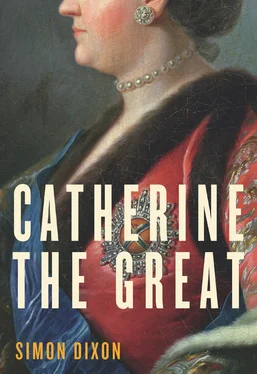The routine established in these early days set the pattern for the remainder of the journey. While ashore, Catherine divided her time in the manner anticipated by the Geographical Description in a programme guided by the young president of the Academy of Sciences, Vladimir Orlov. Part of it was devoted to inspections of the sorts of prosperous economic enterprise that she wanted to promote in Russia (the head of the College of Manufactures, Dimitry Volkov, was another of her companions on board the Tver ). A fortnight before leaving Moscow, she had secretly decreed that small, unregistered workshops there should no longer be persecuted by the authorities. Matching her instinctive preference for free labour, this policy was also influenced by Catherine’s reading of the Cameralist economist Jacob Bielfeld, who believed that large, privileged manufactories were better suited to the provinces than to a capital city. ‘The excessive aggrandizement of a capital which is made at the expense of provincial towns, can never be a sign of a state’s prosperity,’ Bielfeld insisted, in a passage that played directly into the empress’s prejudices against Moscow. 24Now she planned to inspect some of Russia’s largest textile manufactories in the Volga region. Despite this preoccupation with the modern economy, however, by far the greater part of her journey was taken up by visits to monasteries and churches where she could conveniently associate herself with medieval princely glories. Here the clergy could show off their miracle-working icons to a sceptical empress while the populace presented her with the traditional symbols of Russian hospitality: bread and salt (usually delivered on silverware made expressly for the occasion), and fish (preferably still live and wriggling).
While under sail, Catherine’s priorities were different again. One of the books that she had set aside for the journey was Bélisaire , a political novel by the philosophe Jean-François Marmontel, which had been banned in France as openly deist. On 7 May, stuck at anchor in a howling headwind, she found time to thank the author. ‘I was enchanted to read it and I wasn’t the only one: it is a book that deserves to be translated into every language.’ As good as her word, she and her companions whiled away the delay by completing the Russian version begun in Tver. It was dedicated to Archbishop Gavriil, whose virtues, listed in the inscription by Voltaire’s friend Count Andrey Shuvalov, were said to include ‘gentleness, humility, moderation [and] enlightened devotion’. 25The empress herself translated the chapter on monarchy which projected the image of a just and tolerant ruler that she hoped to propagate by distributing the book throughout the empire (it was published in the following year). 26The weather defeated even the maps in the Geographical Description . ‘I know not where to date my letter from,’ she complained, ‘since I am on a vessel in the middle of the Volga in some rather nasty weather that many ladies would call a frightful storm.’ 27‘Yesterday was the first boring day,’ she confessed to Moscow’s Governor General next morning, ‘but we are all healthy, and although there are close on two thousand people in my entourage, only five are in hospital, and they are not seriously ill. And although troops have been sent to replace the sick soldiers, those on my galley don’t want to leave and say that they are well.’ 28
A flotilla of small craft decked with multicoloured flags came out to greet her at Yaroslavl on 9 May. The town ‘could hardly be better situated’, she boasted, ‘it is very pleasing to everyone’. Not quite: Vladimir Orlov found the place ‘very badly built, almost all of peasant huts, the streets are narrow and paved with planks’. He was more impressed by a visit to Ivan Zatrapezny’s silk works, which had not only supplied many of the hangings in the imperial palaces, but also exported more than 65,000 yards of cloth to England in the previous year. Having taken coffee and dessert with the proprietor’s family, Catherine was briefly shown some of their wares before sailing over to Savva Yakovlev’s equally thriving enterprise on the opposite side of the river. Orlov, who returned two days later for a more detailed demonstration, learned that 3000 people worked for Zatrapezny in winter, and since there were ‘incomparably more at the Sobakina factory’, he could count on a combined winter workforce of up to 10,000. Most of them were serfs belonging to Prince Mikhail Shcherbatov, elected to the Legislative Commission in March as the noble deputy for Yaroslavl. Shcherbatov, the most ardent defender of Russia’s ancient aristocracy against the pretensions of the service nobility promoted since the time of Peter the Great, was no less critical of lethargic merchants, but since his serfs would otherwise have remained idle in winter, he released them to the enterprising Zatrapezny in exchange for capital to invest in his own weaving sheds, which in turn supplied semi-finished cloth to the larger manufactories. 29
Having inspected four such enterprises in and around Yaroslavl, interspersed with visits to local monasteries, Catherine chose to relax as she might have done in St Petersburg. After lunch with the ambassadors, she played cards with them in her apartments and sat down to dinner at a table ‘laid with fitting magnificence and decorated with pyramids of flaming crystal bottles, covered with white wax, which looked very handsome’. 30After such a banquet, Catherine was pleased to report to Panin, ‘the diplomatic corps is apparently very happy and will travel to Kostroma, where the nobles are making great preparations for my arrival tomorrow’. The Yaroslavl nobility had already made a good impression when they were presented to her in the archbishop’s refectory, built by Patriarch Filaret in 1634 on the model of the Kremlin’s Palace of Facets: ‘It was all very seemly,’ the empress reported. Meanwhile, she asked for more government papers to be sent to her: ‘I live idly in the extreme.’ 31
For all her professed inactivity, Catherine looked tired on her first morning in Kostroma. Although the obligatory triumphal arch had been built at the entrance to the cathedral, the town could provide no accommodation fit for an empress and she had been obliged to sleep on her galley. 32Lunch helped to revive her, and so did reports on the five local textile works, whose rival owners, she was pleased to learn, lived in the sort of harmony she desired for all her subjects. No effort was spared to make Muscovite comparisons explicit, though the aim was always to show that Catherine had surpassed rather than merely imitated past triumphs. Bibikov struck a suitably flattering note by comparing her with Tsar Mikhail Fëdorovich, the founder of the Romanov dynasty who had travelled from the nearby Ipatyevsky monastery to accept the crown in 1613: ‘What joy this town experienced in the presence of that Sovereign, and what joy it must feel now, when you take incomparably greater care of our well-being!’ 33For Catherine’s visit to the monastery on 15 May, the ‘tsar’s place’ built for Mikhail—an intricately carved canopy almost thirty feet tall which had been stored away since the fire of 1649—was restored to the Trinity Cathedral and carved with her monogram as a memento for posterity. 34
Next day, she sailed on to an estate belonging to the family of Bibikov’s wife, Anastasia Kozlovskaya. Despite their modest means, the Kozlovskys had not only found the wherewithal for a new quayside, but also built the obligatory triumphal gate opposite the empress’s mooring, topped by a crown and with several obelisks to one side. Their investment was rewarded by an invitation to dine on the Tver. And there was more to come. On Ascension Day, 17 May, Catherine was greeted by cheering crowds of neighbouring nobles, merchants and clergy as she followed the procession of the cross up a path flanked by prostrate peasants. During the service, Bibikov himself read from the Gospel at her request. At lunch, Catherine was served by the daughters of the family and her hosts proposed a toast on their knees. She, in turn, enrolled Bibikov’s seven-year-old son as a junior court official. There could hardly have been a more telling ritual celebration of the mutual bonds between a sovereign and her subjects. Although there was never any question of a formal contract between Catherine and the Russian people, she was fully aware of the implicit bargain represented by the cruise. ‘Settlements are very frequent,’ she told her son, ‘and people are all glad to see me, but I know the proverb “one hand washes the other” and so I behave in the same way towards them.’ 35
Читать дальше












